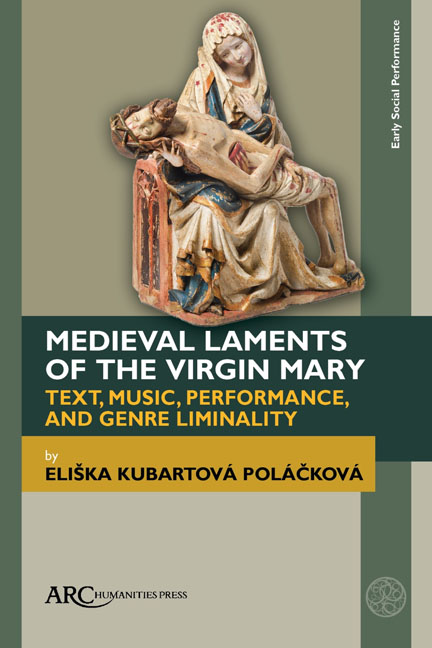Book contents
- Frontmatter
- Contents
- List of Illustrations
- Preface
- Introduction. The Suffering of the Virgin Mary as an Inner Drama
- Chapter One Marian Lament and Medieval Piety
- Chapter Two Genre, Mediality and Aesthetics
- Chapter Three Modes of Performance
- Chapter Four Bohemian Laments: Feeling Like a Woman, Thinking Like a Man. Or Not?
- Appendix: Bohemian Marian Laments — Excerpts
- Bibliography
- Index
Chapter Two - Genre, Mediality and Aesthetics
Published online by Cambridge University Press: 28 December 2023
- Frontmatter
- Contents
- List of Illustrations
- Preface
- Introduction. The Suffering of the Virgin Mary as an Inner Drama
- Chapter One Marian Lament and Medieval Piety
- Chapter Two Genre, Mediality and Aesthetics
- Chapter Three Modes of Performance
- Chapter Four Bohemian Laments: Feeling Like a Woman, Thinking Like a Man. Or Not?
- Appendix: Bohemian Marian Laments — Excerpts
- Bibliography
- Index
Summary
IF WE ASKED for the generic characteristics of medieval and early modern Marian Lament, major difficulties would arise with providing any working definition of the genre that would be neither intolerably general, nor unproductively narrow. Though various definitions have been suggested, most of them seem to overlook or deliberately exclude one or more types of text which other authors regard as belonging to the group. Therefore, while there is general agreement that the genre is primarily defined by its content, i.e. the lamentation of the Virgin over the suffering and death of her son, there is much less agreement on which particular texts and groups of texts should be counted under the umbrella term “Marian Lament”; some scholars are even hesitant to call Marian Lament a distinctive genre.
One body of definitions stems from understanding the planctus Mariae as a type of song (i.e., a literary and musical genre), related to other medieval planctus or laments, both Latin and vernacular, such as dirges for the dead (Totenklage), female mourning, biblical planctus, complaintes dʼamour, etc. John Stevens sees Marian Lament as a sub-genre of medieval lament, defining it as dramatic or semi-dramatic compositions featuring the lament of the Virgin Mary. According to Stevens, the planctus Beatae Virginis Mariae represents “the most important type of planctus in the twelfth and thirteenth centuries [which] appears in all European countries,” that is, not defined by its verse structure, as it can appear either in the form of a sequence or a lai. This view has been supported by other scholars, such as David Hiley, who categorizes the early Planctus ante nescia and Flete fideles animae as sequences with paired strophes which, nevertheless, resemble the secular lai because of the length of their strophes and their varied length and rhythm. Similarly, Janthia Yearley has it that the typical form of Marian Lament is that of a sequence and lai, underlining the relation of words and music in the planctus Mariae as a genre intended primarily for singing.
- Type
- Chapter
- Information
- Medieval Laments of the Virgin MaryText, Music, Performance, and Genre Liminality, pp. 75 - 132Publisher: Amsterdam University PressPrint publication year: 2023



